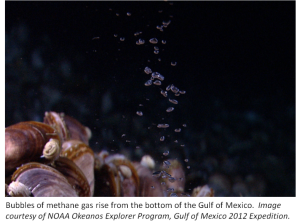Description:
Bubbles of methane gas can be found escaping the seabed throughout the worlds oceans. Methane is a key greenhouse gas, and any gas escaping the seabed that reaches the atmosphere has the potential to affect climate. Methane seeps also act as an energy source for chemosynthetic communities in the deep ocean, and are important to understand when assessing the anthropogenic impacts of deepwater oil and gas extraction. For all of these reasons, it is important to find the locations of methane seeps, to measure the flux of methane escaping the seabed at the seep locations, and to understand the ultimate fate of the methane within them (e.g., how much methane is dissolved in the ocean and how much reaches the atmosphere).
At UNH we are using acoustics to help answer some of these questions. The technologies we employ include state-of-the-art multibeam echosounders which can be used to map the ocean very efficiently, and calibrated split-beam echosounders which we have used to help quantify the flux of gas escaping the seabed. Our work exploits one of the key mechanical characteristics of bubbles: if they are excited by an acoustic wave at or near their resonance frequency, bubbles will very effectively ‘scatter’ acoustic waves in all directions. This allows us to acoustically observe bubbles from surface vessels even in the deep ocean where we might be a few kilometers above the seabed.
Despite the advantages of acoustic remote sensing, it sometimes helps to get close to the bubble plumes in order to measure bubble sizes and, where possible, directly estimate the methane flux. To this end, we have been fortunate to be able to collaborate with NOAA’s Office of Exploration and Research, which operates tethered remotely operated vehicles (ROV’s) that can illuminate, image, and observe deep ocean processes at ranges of only a few meters.
Contacts:
Thomas Weber
Email: weber@ccom.unh.edu
Phone: (603) 862-1659
